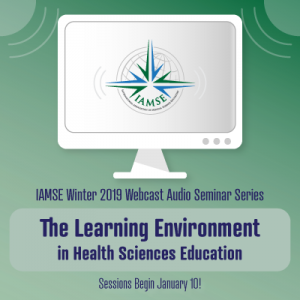
[The following notes were generated by Michele Haight, PhD]
IAMSE Webinar Series, Winter 2019
Speakers: Sean Tackett MD, MPH
Title: The Learning Environment: An International Perspective
Series: The Learning Environment in Health Sciences Education
- Learning environment definition: “The learning environment refers to the social interactions, organizational culture and structures and physical and virtual spaces that surround and shape the learners’ experiences, perceptions and learning.” (Josiah Macy Jr. Conference, 2018)
- Review of the four domains of Gruppen’s 2018 conceptual model for the learning environment:
- Personal
- Social
- Organizational
- Physical and Virtual Spaces
These domains correspond to the JHLES and DREEM frameworks.
DREEM is the most popular framework for measuring learning environment
perceptions.
- The learning environment is messy, challenging and important. Given this, we should not back down from challenges of engaging with it.
- The global medical education landscape:
- 3000 medical schools in 185 countries with an estimate of >2million medicals students.
- The US medical education landscape:
- 183 medical schools with 0.09 million students.
- Cost in US $300K/student (cost in China $14K/student).
- Globally, the number of medical schools has been increasing while the ratio of medical schools to population has been decreasing. We need more medical schools.
- Models of medical education systems vary a lot making the learning environment more complex and more difficult to measure.
- Factors contributing to the overall complexity of learning environments in international medical education include the following:
- rapidly growing number of medical schools
- increasing institutional collaborations
- increasing student migration
- variation in curricular models
- uneven coverage by regulatory/accreditation authorities (limit abilities to standardize medical education systems)
- Uneven resources with exceptionally challenging situations
- Understanding one individual’s learning environment is already complex. Complexity increases when measuring at an institution, health system and inter-health system levels.
- A plurality of research done on the learning environment comes from high-income countries.
- International comparison studies in learning environment perceptions appear to yield useful data. For example, in an international comparison study, learning environment perceptions associated with quality of life but did not strongly associate with empathy. Much more research needs to be done to strengthen the evidence.
- Accreditation bodies need to spearhead research on the learning environment. There is a movement to standardize international accreditation and therefore standardize the data collection for accrediting purposes. This will enable research across institutions.